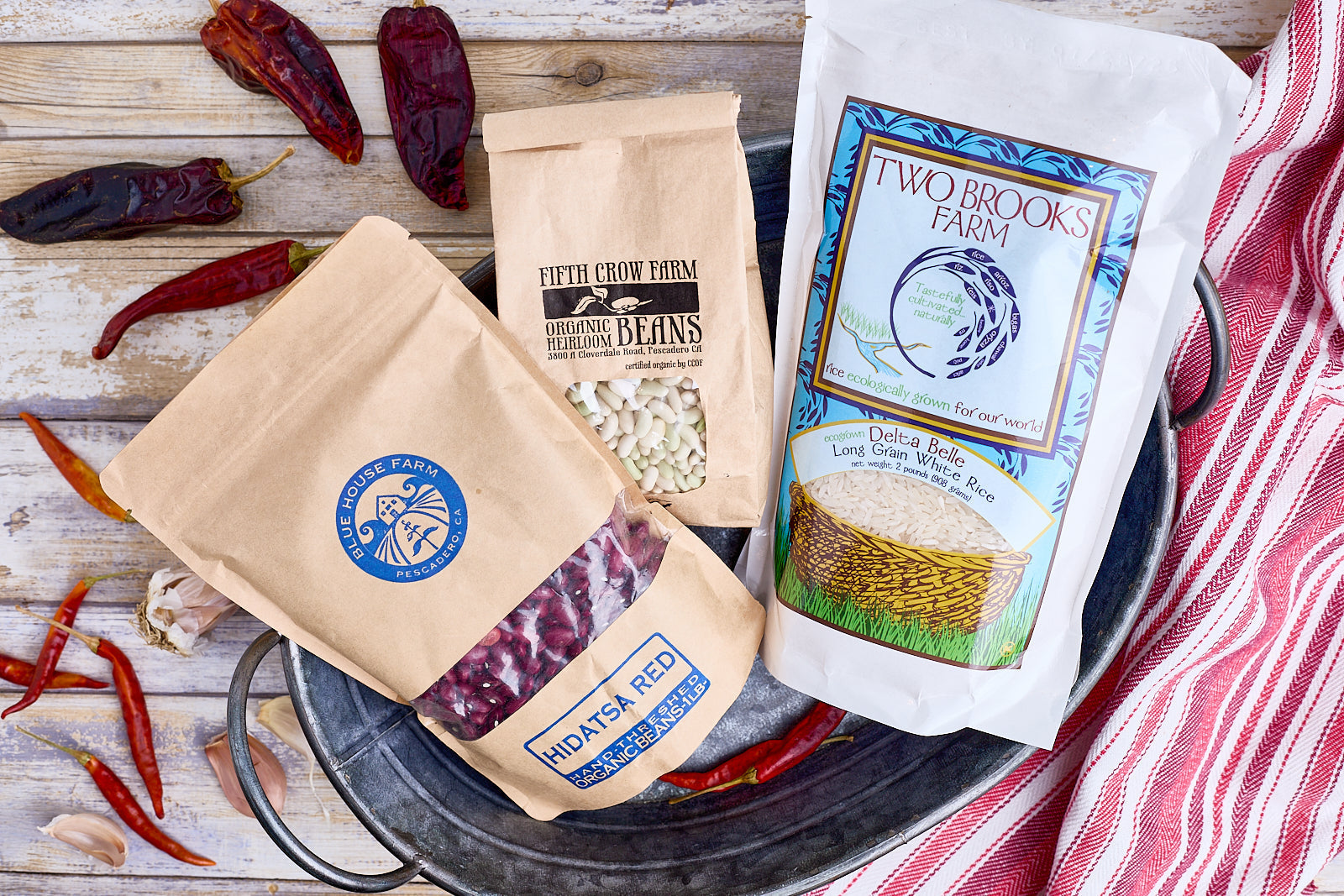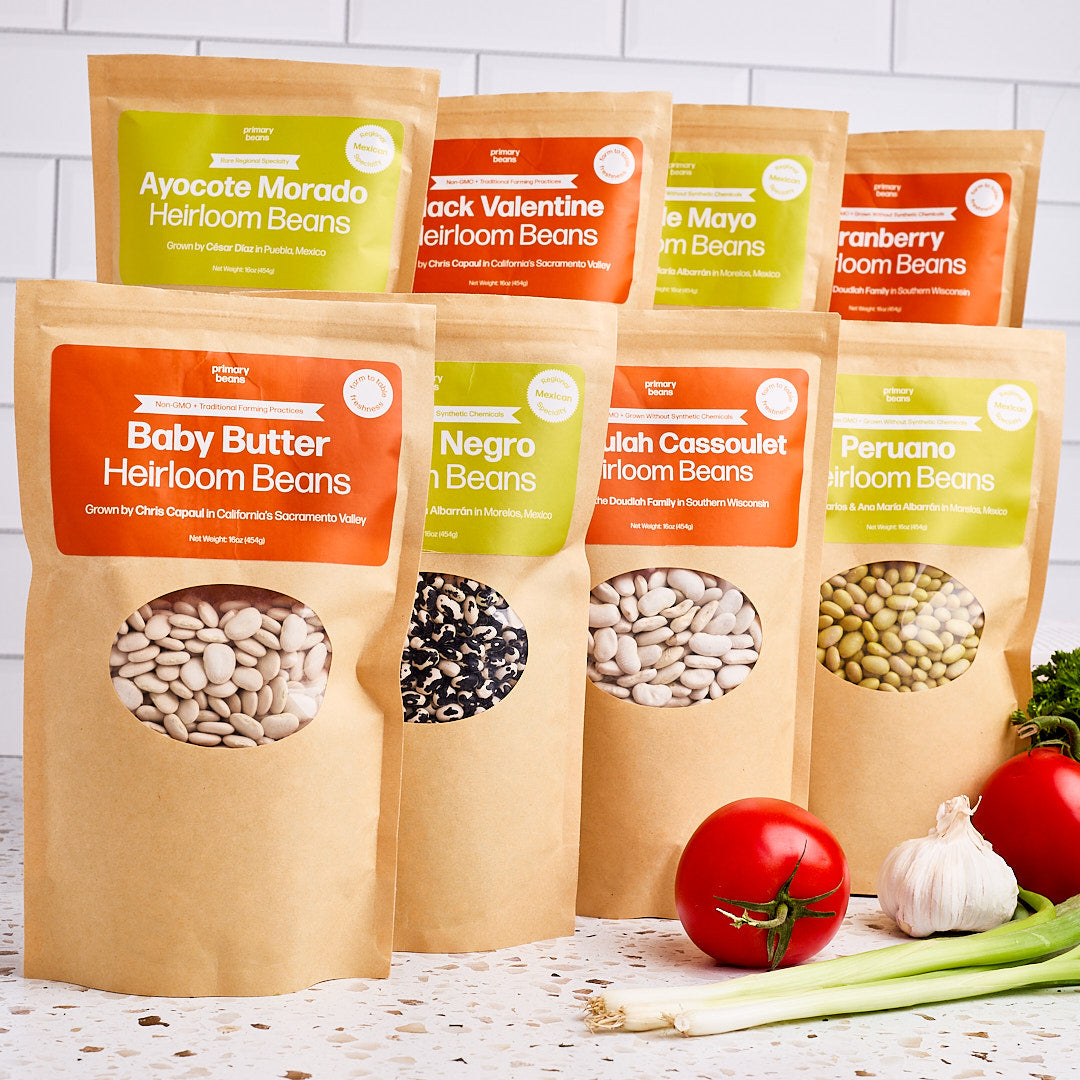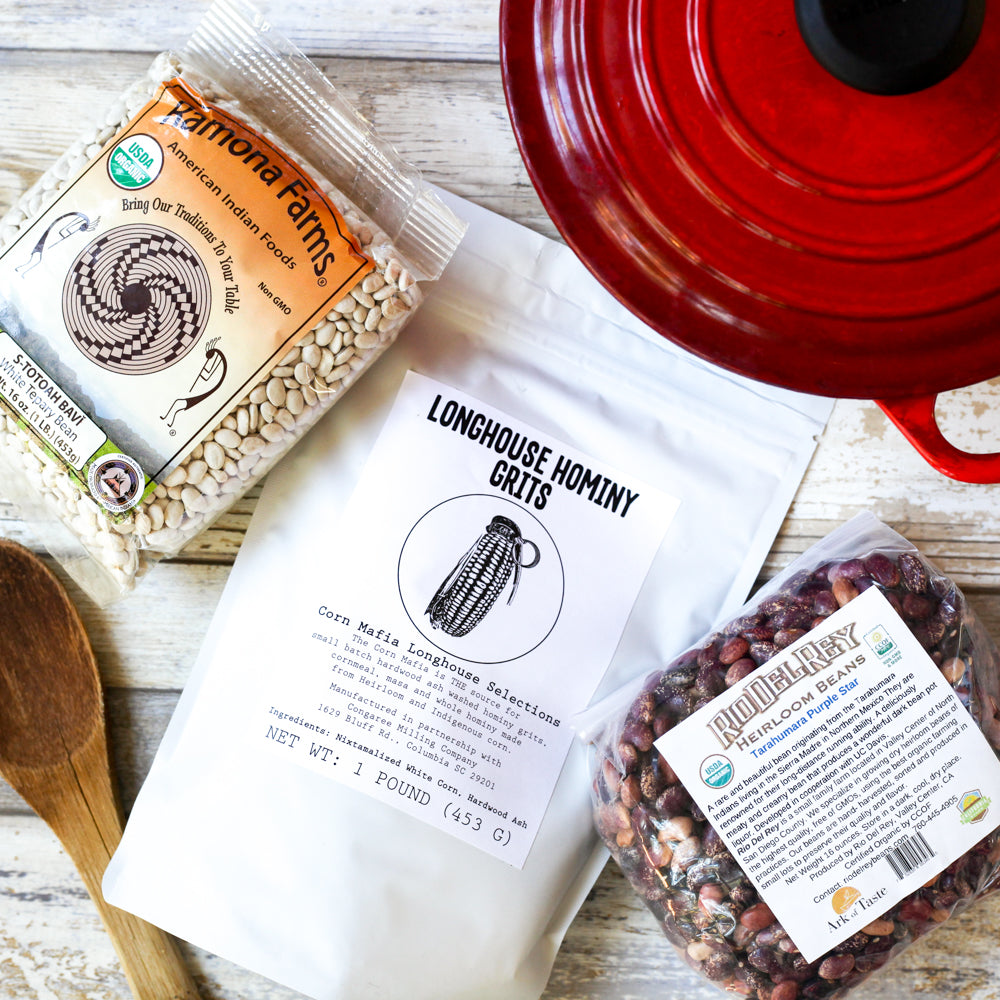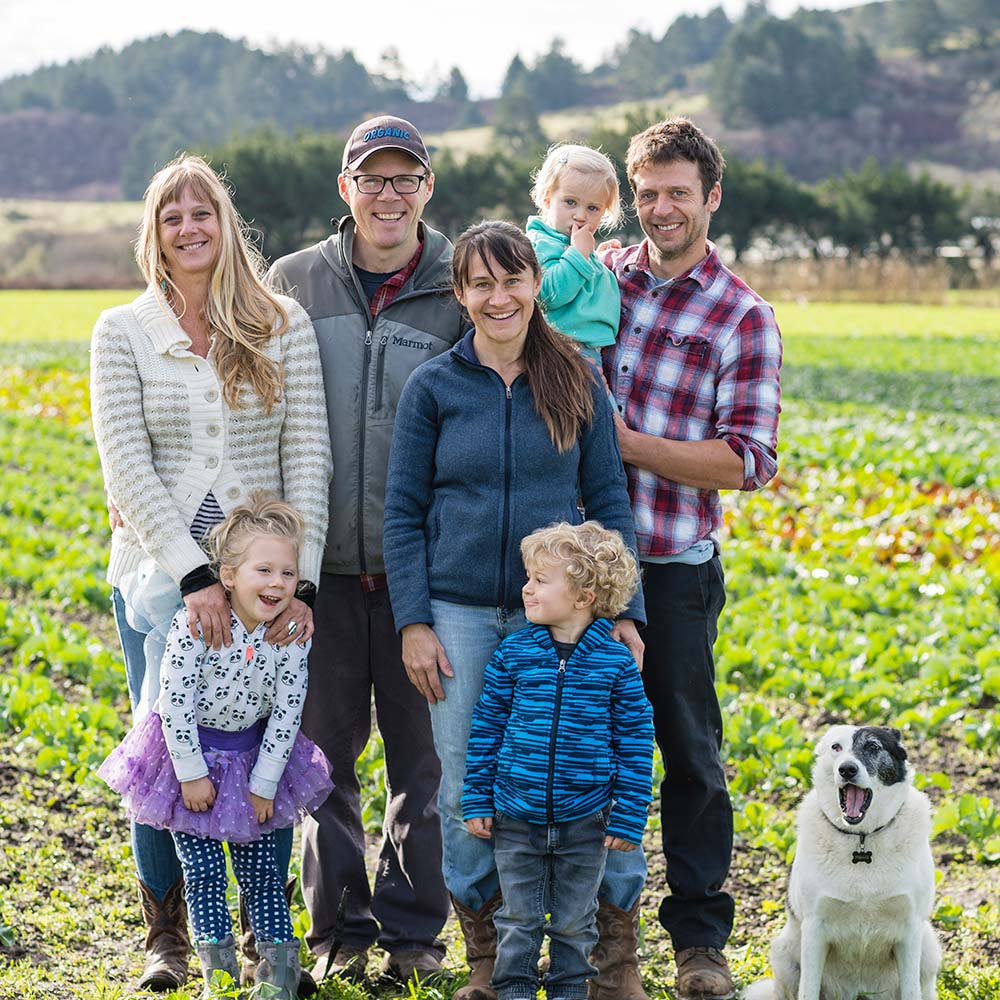10.99 FLAT RATE SHIPPING
10.99 FLAT RATE SHIPPING
SHOP

MARCH 2025 HEIRLOOM BEAN AND GRAIN CLUB
February 18, 2025 6 min read
March’s Heirloom Bean and Grain Club selection is a celebration of tradition, sustainability, and the changing seasons. This month, we’re featuring Organic Hidatsa Red Beans, Organic Flageolet Beans, and Regeneratively Farmed Delta Belle Rice—heirloom ingredients grown with care on small family farms. The Hidatsa Red Beans and Delta Belle Rice are the perfect duo for a classic pot of red beans and rice, just in time for Mardi Gras. The Hidatsa Red Beans create a rich, velvety broth that pairs beautifully with the aromatic, regeneratively grown Delta Belle Rice, making for a dish steeped in history and comfort. Meanwhile, the delicate, minty green Flageolet Beans bring a bright, springtime touch to soups and salads, holding their shape beautifully while adding a subtle, creamy texture. Whether you’re cooking up a festive feast or embracing the fresh flavors of the season, this month’s selection is all about honoring the past while savoring the present.
THE BEAN AND GRAIN BOX CONTAINS:
Organic Hidatsa Red Beans, Organic Flageolet Beans, Regeneratively Farmed Delta Belle Rice
THE BEAN ONLY CONTAINS:
Organic Hidatsa Red Beans, Organic Flageolet Beans,
OUR NEW AND IMPROVED CUSTOMER PORTAL
Now you can easily claim rewards, add to your next shipment and so much more! We made a video walking you through exactly how easy it is to add some goodies to your order and get cash back. WATCH THE VIDEO.
NEW TO THE CLUB? Check out our blogposts with everything you need to know to get the most out of your membership in the heirloom bean and grain club.
How To Cook A Perfect Pot of Beans
The Definitive Guide To Cooking Beans
ORGANIC HIDATSA RED BEANS
The Hidatsa Red Bean is a true heirloom treasure, cultivated for centuries by the Hidatsa people of the Missouri River Valley in North Dakota. This deep red bean was first recorded by Lewis and Clark during their 1804-1805 winter stay at Knife River and later grown in Thomas Jefferson’s gardens at Monticello. In 1915, seed pioneer Oscar Will introduced it to the public in his Pioneer Indian Collection of Seeds, and today, it is recognized in the Slow Food Ark of Taste for its rich cultural and culinary history. Traditionally, the Hidatsa people allowed the pods to dry on the vine before hand-harvesting the beans, a practice that preserves both the integrity of the seeds and the connection to their agricultural roots.
With its nutty flavor, firm texture, and ability to create a rich, savory broth, the Hidatsa Red Bean is a standout in slow-cooked dishes, from soups to stews. Its natural resilience and deep history make it more than just an ingredient—it’s a connection to Indigenous foodways and sustainable agriculture. Whether simmered with aromatics or paired with grains, this bean brings depth and tradition to every meal.

WHAT TO DO WITH THEM
Use these in any recipe that calls for red beans and you'll be astounded by the powerful flavor from these little red beans. One of my new favorite recipes is our take on red beans and rice. This 100% vegan version of the cajun classic will fool even the most ardent meat eaters! It's been tested and approved by our Baton Rouge taste testers. We're ditching the traditional ham and sausage and replacing it with umami filled kombu. The natural glutamates in the kombu enhances the flavors of the dish like mother nature's MSG and the umami mimics the meat products nobody will ever miss them. All the flavor, none of the carcinogenic meat products. Did you know that the World Health Organization categorized bacon and sausage as carcinogens?
ORGANIC FLAGEOLET BEANS
Making it's first appearance in the club since 2023, this heirloom bean is a French classic and one of our favorites. They are minty green to white when dried but turn creamy white when cooked. Each year the color will vary slightly and even from the same plant the color will vary depending on how long the bean stayed on the plant before it was harvested. Why? Because it is impossible to get an entire field to ripen at once.
WHAT TO DO WITH THEM
Flageolet is mild and creamy and pairs perfectly with chicken, fish or lamb but also make a wonderful vegetarian dish. We love it in our Roasted Cauliflower and Flageolet Soup. It is a classic spring bean paired with lamb as in this recipe from New York Times. They work great in anything slow cooked like a cassoulet because although they are mild and tender they hold their shape with long cooking. We love them slow cooked on the stove with stock, onion and tomatoes. The flageolet is a favorite among many chefs for everything from soups to sides and they'll find a perfect place on your table. This delicious lemony salad by Martha Stewart is a staff favorite and we think it would make a great addition to your Easter or Passover table. If you're looking for something a little warmer, this creamy flageolet soup recipe from New York Times is delicious.

ABOUT THE FARMER
Fifth Crow Farms is an organic family owned farm in Pescadero, California. Grounded in a values-based approach to land stewardship, Fifth Crow Farm is a dynamic and diversified organic farm in Pescadero, CA. Founded in 2008 with a shoestring budget, a supportive local community, and ambitious dreams, they strive to bring eaters the highest quality, best tasting, and most nutritious food possible.
Fifth Crow Farm wants their farm to be more than a business: they strive to make it an engine for positive change in the food system. They are stewarding the land in a way that not only respects but improves habitat for wildlife and builds better soil for future farmers. They also believe in creating a healthy, fulfilling, and fair work environment, and providing their customers with the best tasting, most nutritious, highest quality food possible.
REGENERATIVELY FARMED DELTA BELLE RICE
When we created our vegan Red Beans and Rice recipe, the one thing we were missing was a true Mississippi Delta long grain white rice. We found our perfect ingredient in Two Brooks Farm which has taken up the mantle from their friend and neighbor, the famed Delta Blues Rice which is no longer available. With a buttery, sweet flavor and a springy chew, it is the most delicious long grain white rice we've ever tasted. Perhaps it's the rich mineral content of the bayou soil at Two Brooks Farm that makes it exceptional. Maybe it's their regenerative practices or the Non-GMO seeds they sow on the family farm that make it special.
A Brief History Of Rice In The US
Rice was first grown in the US in the Low Country of South Carolina and Northern Georgia. Carolina Gold Rice was brought to the US from Africa and cultivated by enslaved people. This distinct rice became the staple of regional dishes like Hoppin' John. After rice farming became industrialized rice production moved to the Delta region and new varieties of long grain rice were favored. In California, short grain rice from Japan became an essential ingredient for the region used by the large Japanese American population.
HOW TO USE IT
Delta style long grain rice is traditional in Mississippi and Louisiana dishes ranging from étouffée to jambalaya.
ABOUT THE FARMERS

Two Brooks Rice is the product of years of reflection on our food production systems and how those impact our natural world. As a 10th generation farming family, Lawrence, Abbey and Sarah live and farm on the bayou in the most charming of Mississippi’s small towns-- Sumner. Theirs is a farm that lives in harmony with nature, giving back more than it takes. They practice no-till farming, they use no pesticides and they capture rain water and runoff to conserve our water resources. “Years ago, after watching the overwintering waterfowl population explode, and the benefits they give to the land, after watching the eagles roost around, after watching the deer population go up, I started thinking about what I was doing. I started thinking about the soil microbiology and biology. How, by the fact that we had curtailed tillage and allowed waterfowl to do the tillage, we were beginning to rebuild the soil structure with naturally living organisms that enhance the rice plants health, and require far fewer synthetic inputs (to this day I use no insecticides or fungicides).”
Recent Articles
About Us
Foodocracy is dedicated to creating a more sustainable and independent food system. We support small, independent farms across the nation.
Get impossible to find beans and grains shipped direct to your doorstep each month from small family farms.
We support small, family owned farms across the nation. Did you know that farmers only make an average of 10 cents on every dollar you spend at the supermarket? Working directly with farms and not middle men ensures that more money goes back to the people actually growning your food.
Get 10% Off
Sign up for delicious recipes and special offers.
**Regularly priced items only.




